Impact of Macro-Economic Policies on Business Environment - Analysis
VerifiedAdded on 2022/12/14
|13
|3938
|58
Report
AI Summary
This report delves into the intricate relationship between business management and macro-economic policies. It begins by outlining general economic concerns such as inflation and tariffs, then examines the impact of government policies, labor markets, income distribution, and employment on the business environment. The report further explores monetary policies, including supply and demand dynamics, key influencing factors, and their implications. Fiscal policy, taxation, social security, and public expenditure are also discussed. Capital markets, including primary and secondary markets, crowdfunding, and cryptocurrencies, are analyzed to provide a comprehensive overview of the economic landscape. The report emphasizes the interconnectedness of these factors and their combined influence on business operations and growth.
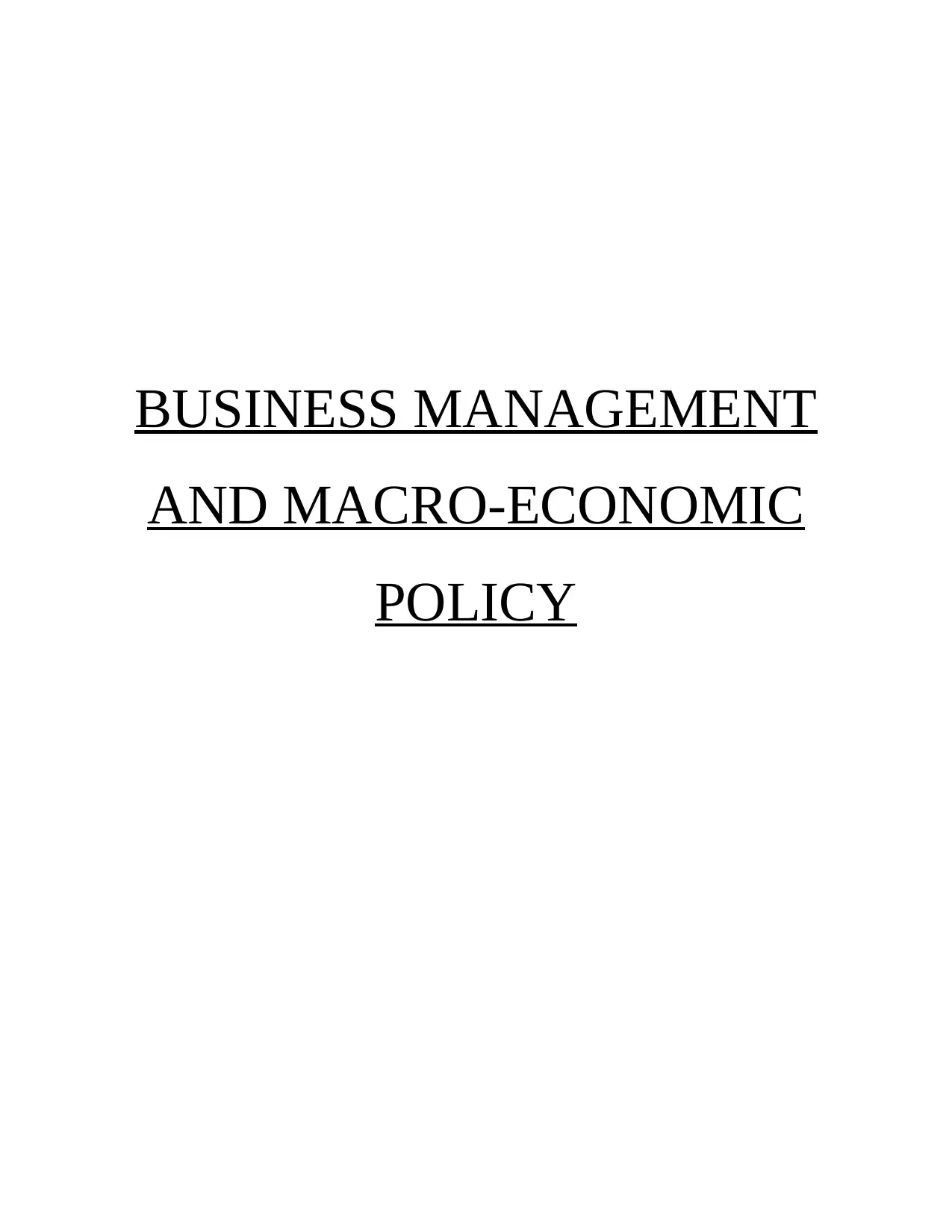
BUSINESS MANAGEMENT
AND MACRO-ECONOMIC
POLICY
AND MACRO-ECONOMIC
POLICY
Paraphrase This Document
Need a fresh take? Get an instant paraphrase of this document with our AI Paraphraser
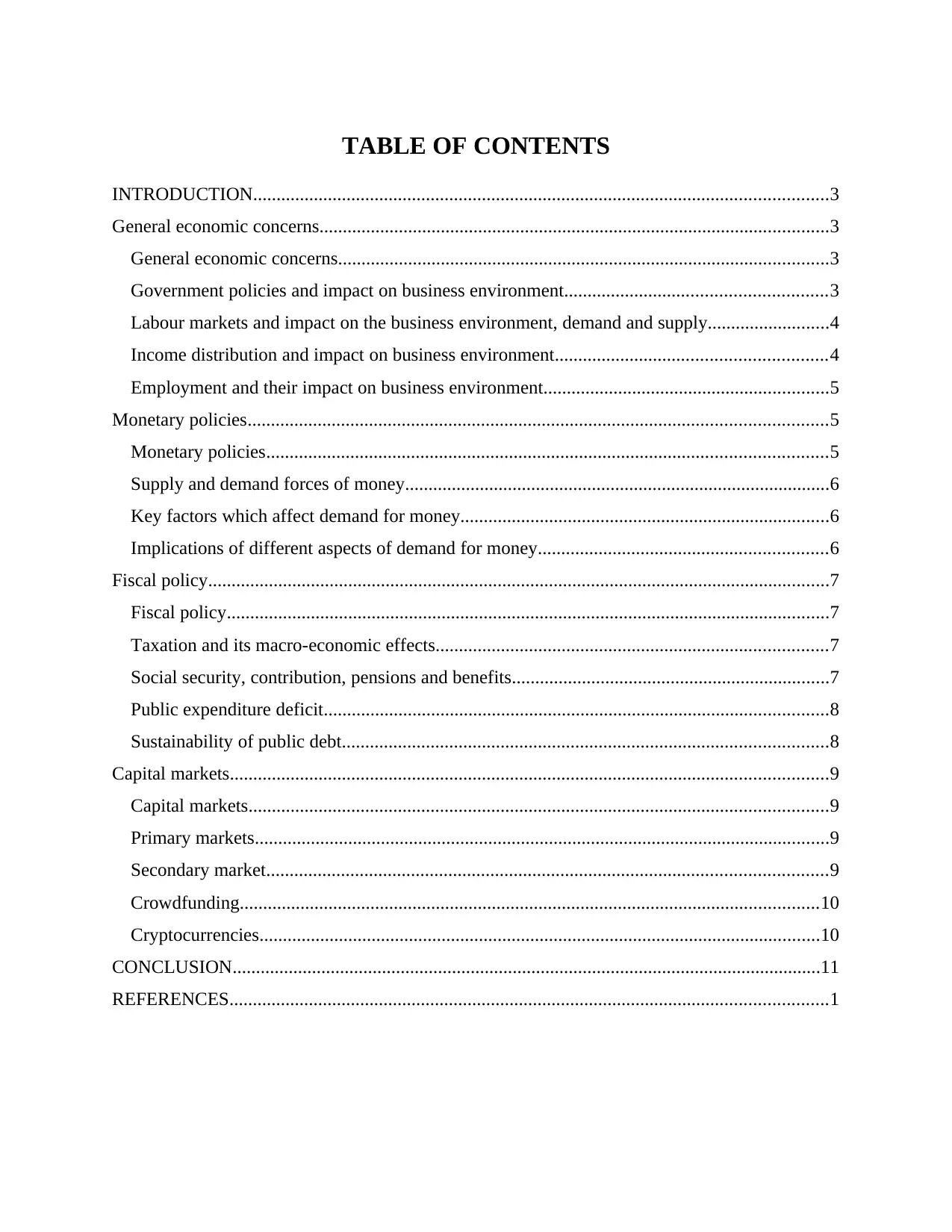
TABLE OF CONTENTS
INTRODUCTION...........................................................................................................................3
General economic concerns.............................................................................................................3
General economic concerns.........................................................................................................3
Government policies and impact on business environment........................................................3
Labour markets and impact on the business environment, demand and supply..........................4
Income distribution and impact on business environment..........................................................4
Employment and their impact on business environment.............................................................5
Monetary policies............................................................................................................................5
Monetary policies........................................................................................................................5
Supply and demand forces of money...........................................................................................6
Key factors which affect demand for money...............................................................................6
Implications of different aspects of demand for money..............................................................6
Fiscal policy.....................................................................................................................................7
Fiscal policy.................................................................................................................................7
Taxation and its macro-economic effects....................................................................................7
Social security, contribution, pensions and benefits....................................................................7
Public expenditure deficit............................................................................................................8
Sustainability of public debt........................................................................................................8
Capital markets................................................................................................................................9
Capital markets............................................................................................................................9
Primary markets...........................................................................................................................9
Secondary market........................................................................................................................9
Crowdfunding............................................................................................................................10
Cryptocurrencies........................................................................................................................10
CONCLUSION..............................................................................................................................11
REFERENCES................................................................................................................................1
INTRODUCTION...........................................................................................................................3
General economic concerns.............................................................................................................3
General economic concerns.........................................................................................................3
Government policies and impact on business environment........................................................3
Labour markets and impact on the business environment, demand and supply..........................4
Income distribution and impact on business environment..........................................................4
Employment and their impact on business environment.............................................................5
Monetary policies............................................................................................................................5
Monetary policies........................................................................................................................5
Supply and demand forces of money...........................................................................................6
Key factors which affect demand for money...............................................................................6
Implications of different aspects of demand for money..............................................................6
Fiscal policy.....................................................................................................................................7
Fiscal policy.................................................................................................................................7
Taxation and its macro-economic effects....................................................................................7
Social security, contribution, pensions and benefits....................................................................7
Public expenditure deficit............................................................................................................8
Sustainability of public debt........................................................................................................8
Capital markets................................................................................................................................9
Capital markets............................................................................................................................9
Primary markets...........................................................................................................................9
Secondary market........................................................................................................................9
Crowdfunding............................................................................................................................10
Cryptocurrencies........................................................................................................................10
CONCLUSION..............................................................................................................................11
REFERENCES................................................................................................................................1
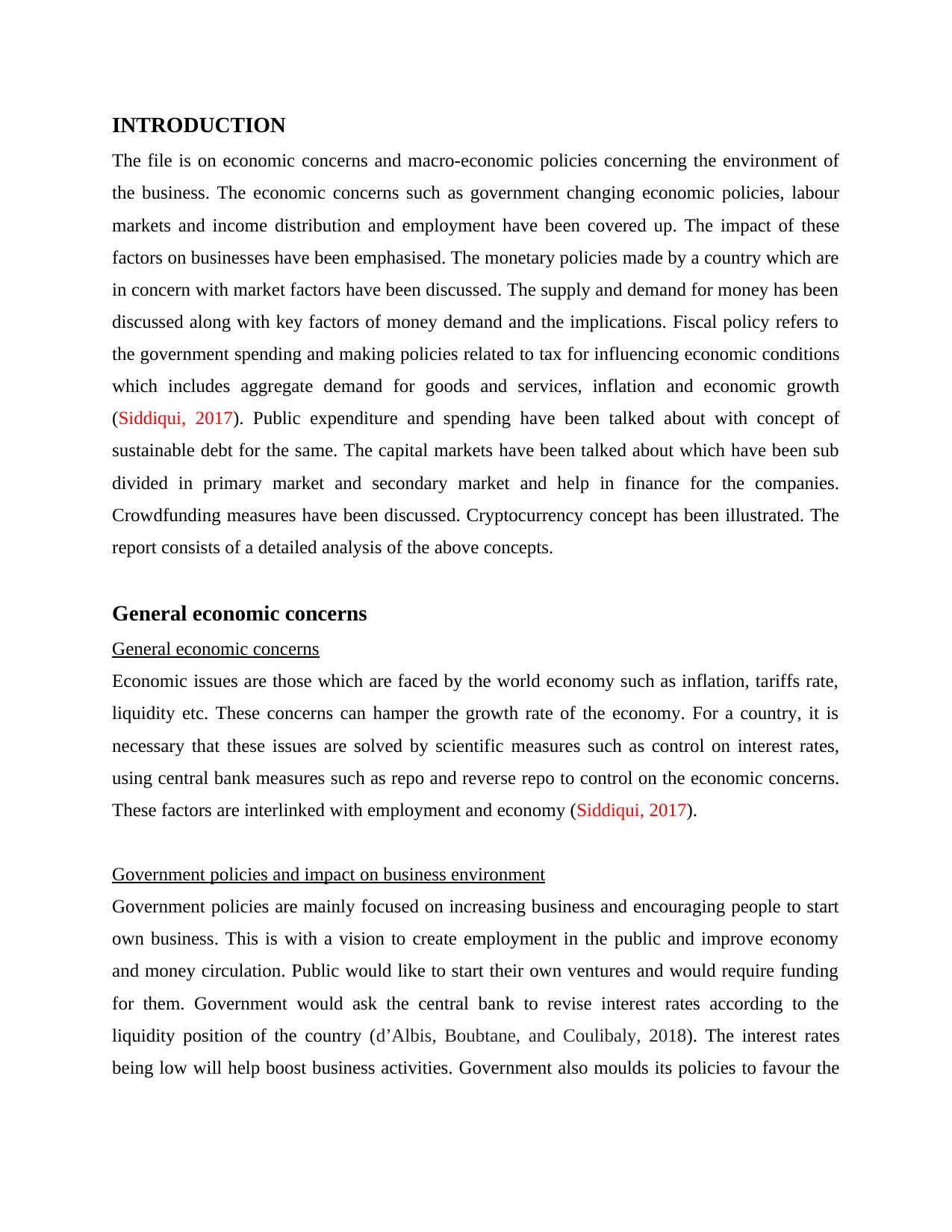
INTRODUCTION
The file is on economic concerns and macro-economic policies concerning the environment of
the business. The economic concerns such as government changing economic policies, labour
markets and income distribution and employment have been covered up. The impact of these
factors on businesses have been emphasised. The monetary policies made by a country which are
in concern with market factors have been discussed. The supply and demand for money has been
discussed along with key factors of money demand and the implications. Fiscal policy refers to
the government spending and making policies related to tax for influencing economic conditions
which includes aggregate demand for goods and services, inflation and economic growth
(Siddiqui, 2017). Public expenditure and spending have been talked about with concept of
sustainable debt for the same. The capital markets have been talked about which have been sub
divided in primary market and secondary market and help in finance for the companies.
Crowdfunding measures have been discussed. Cryptocurrency concept has been illustrated. The
report consists of a detailed analysis of the above concepts.
General economic concerns
General economic concerns
Economic issues are those which are faced by the world economy such as inflation, tariffs rate,
liquidity etc. These concerns can hamper the growth rate of the economy. For a country, it is
necessary that these issues are solved by scientific measures such as control on interest rates,
using central bank measures such as repo and reverse repo to control on the economic concerns.
These factors are interlinked with employment and economy (Siddiqui, 2017).
Government policies and impact on business environment
Government policies are mainly focused on increasing business and encouraging people to start
own business. This is with a vision to create employment in the public and improve economy
and money circulation. Public would like to start their own ventures and would require funding
for them. Government would ask the central bank to revise interest rates according to the
liquidity position of the country (d’Albis, Boubtane, and Coulibaly, 2018). The interest rates
being low will help boost business activities. Government also moulds its policies to favour the
The file is on economic concerns and macro-economic policies concerning the environment of
the business. The economic concerns such as government changing economic policies, labour
markets and income distribution and employment have been covered up. The impact of these
factors on businesses have been emphasised. The monetary policies made by a country which are
in concern with market factors have been discussed. The supply and demand for money has been
discussed along with key factors of money demand and the implications. Fiscal policy refers to
the government spending and making policies related to tax for influencing economic conditions
which includes aggregate demand for goods and services, inflation and economic growth
(Siddiqui, 2017). Public expenditure and spending have been talked about with concept of
sustainable debt for the same. The capital markets have been talked about which have been sub
divided in primary market and secondary market and help in finance for the companies.
Crowdfunding measures have been discussed. Cryptocurrency concept has been illustrated. The
report consists of a detailed analysis of the above concepts.
General economic concerns
General economic concerns
Economic issues are those which are faced by the world economy such as inflation, tariffs rate,
liquidity etc. These concerns can hamper the growth rate of the economy. For a country, it is
necessary that these issues are solved by scientific measures such as control on interest rates,
using central bank measures such as repo and reverse repo to control on the economic concerns.
These factors are interlinked with employment and economy (Siddiqui, 2017).
Government policies and impact on business environment
Government policies are mainly focused on increasing business and encouraging people to start
own business. This is with a vision to create employment in the public and improve economy
and money circulation. Public would like to start their own ventures and would require funding
for them. Government would ask the central bank to revise interest rates according to the
liquidity position of the country (d’Albis, Boubtane, and Coulibaly, 2018). The interest rates
being low will help boost business activities. Government also moulds its policies to favour the
⊘ This is a preview!⊘
Do you want full access?
Subscribe today to unlock all pages.

Trusted by 1+ million students worldwide
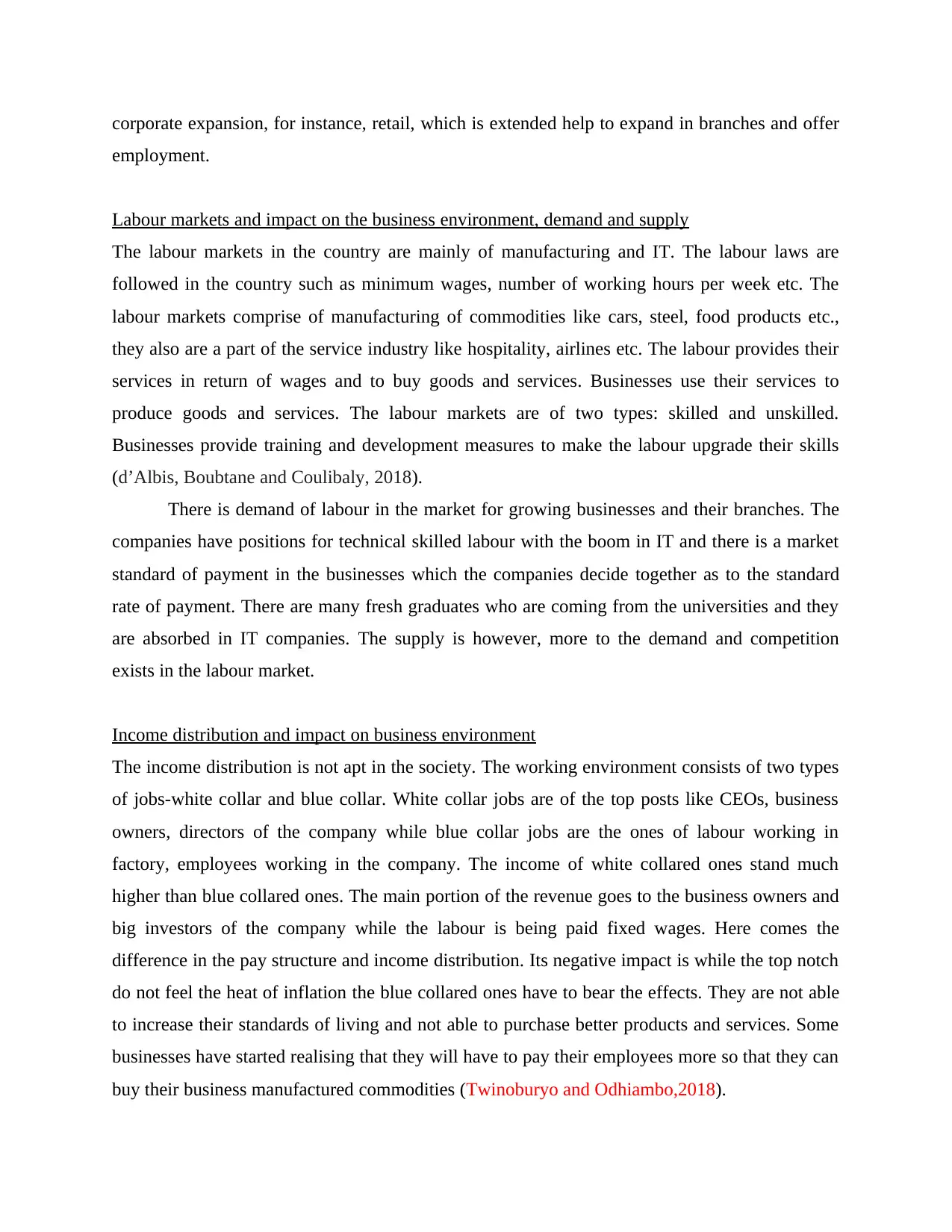
corporate expansion, for instance, retail, which is extended help to expand in branches and offer
employment.
Labour markets and impact on the business environment, demand and supply
The labour markets in the country are mainly of manufacturing and IT. The labour laws are
followed in the country such as minimum wages, number of working hours per week etc. The
labour markets comprise of manufacturing of commodities like cars, steel, food products etc.,
they also are a part of the service industry like hospitality, airlines etc. The labour provides their
services in return of wages and to buy goods and services. Businesses use their services to
produce goods and services. The labour markets are of two types: skilled and unskilled.
Businesses provide training and development measures to make the labour upgrade their skills
(d’Albis, Boubtane and Coulibaly, 2018).
There is demand of labour in the market for growing businesses and their branches. The
companies have positions for technical skilled labour with the boom in IT and there is a market
standard of payment in the businesses which the companies decide together as to the standard
rate of payment. There are many fresh graduates who are coming from the universities and they
are absorbed in IT companies. The supply is however, more to the demand and competition
exists in the labour market.
Income distribution and impact on business environment
The income distribution is not apt in the society. The working environment consists of two types
of jobs-white collar and blue collar. White collar jobs are of the top posts like CEOs, business
owners, directors of the company while blue collar jobs are the ones of labour working in
factory, employees working in the company. The income of white collared ones stand much
higher than blue collared ones. The main portion of the revenue goes to the business owners and
big investors of the company while the labour is being paid fixed wages. Here comes the
difference in the pay structure and income distribution. Its negative impact is while the top notch
do not feel the heat of inflation the blue collared ones have to bear the effects. They are not able
to increase their standards of living and not able to purchase better products and services. Some
businesses have started realising that they will have to pay their employees more so that they can
buy their business manufactured commodities (Twinoburyo and Odhiambo,2018).
employment.
Labour markets and impact on the business environment, demand and supply
The labour markets in the country are mainly of manufacturing and IT. The labour laws are
followed in the country such as minimum wages, number of working hours per week etc. The
labour markets comprise of manufacturing of commodities like cars, steel, food products etc.,
they also are a part of the service industry like hospitality, airlines etc. The labour provides their
services in return of wages and to buy goods and services. Businesses use their services to
produce goods and services. The labour markets are of two types: skilled and unskilled.
Businesses provide training and development measures to make the labour upgrade their skills
(d’Albis, Boubtane and Coulibaly, 2018).
There is demand of labour in the market for growing businesses and their branches. The
companies have positions for technical skilled labour with the boom in IT and there is a market
standard of payment in the businesses which the companies decide together as to the standard
rate of payment. There are many fresh graduates who are coming from the universities and they
are absorbed in IT companies. The supply is however, more to the demand and competition
exists in the labour market.
Income distribution and impact on business environment
The income distribution is not apt in the society. The working environment consists of two types
of jobs-white collar and blue collar. White collar jobs are of the top posts like CEOs, business
owners, directors of the company while blue collar jobs are the ones of labour working in
factory, employees working in the company. The income of white collared ones stand much
higher than blue collared ones. The main portion of the revenue goes to the business owners and
big investors of the company while the labour is being paid fixed wages. Here comes the
difference in the pay structure and income distribution. Its negative impact is while the top notch
do not feel the heat of inflation the blue collared ones have to bear the effects. They are not able
to increase their standards of living and not able to purchase better products and services. Some
businesses have started realising that they will have to pay their employees more so that they can
buy their business manufactured commodities (Twinoburyo and Odhiambo,2018).
Paraphrase This Document
Need a fresh take? Get an instant paraphrase of this document with our AI Paraphraser
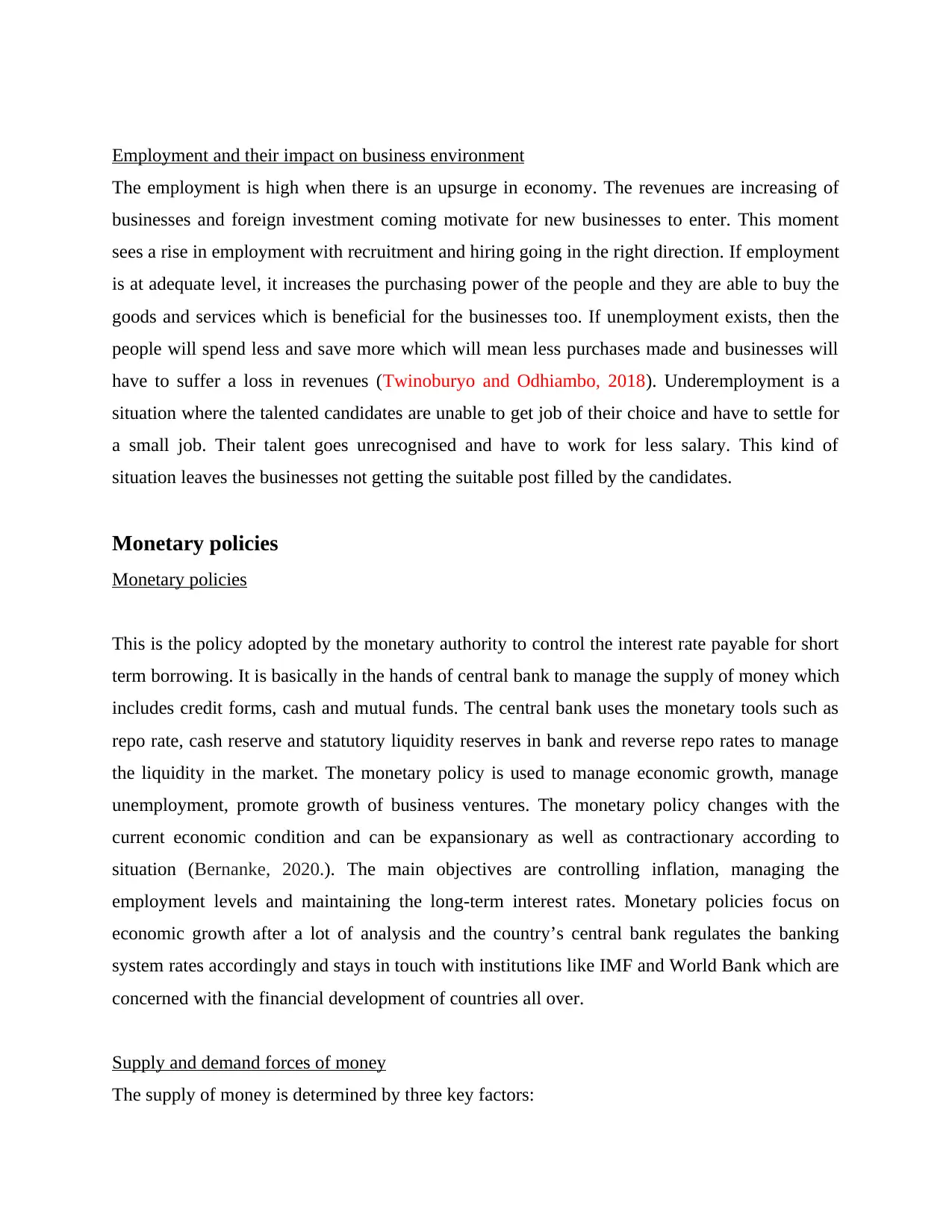
Employment and their impact on business environment
The employment is high when there is an upsurge in economy. The revenues are increasing of
businesses and foreign investment coming motivate for new businesses to enter. This moment
sees a rise in employment with recruitment and hiring going in the right direction. If employment
is at adequate level, it increases the purchasing power of the people and they are able to buy the
goods and services which is beneficial for the businesses too. If unemployment exists, then the
people will spend less and save more which will mean less purchases made and businesses will
have to suffer a loss in revenues (Twinoburyo and Odhiambo, 2018). Underemployment is a
situation where the talented candidates are unable to get job of their choice and have to settle for
a small job. Their talent goes unrecognised and have to work for less salary. This kind of
situation leaves the businesses not getting the suitable post filled by the candidates.
Monetary policies
Monetary policies
This is the policy adopted by the monetary authority to control the interest rate payable for short
term borrowing. It is basically in the hands of central bank to manage the supply of money which
includes credit forms, cash and mutual funds. The central bank uses the monetary tools such as
repo rate, cash reserve and statutory liquidity reserves in bank and reverse repo rates to manage
the liquidity in the market. The monetary policy is used to manage economic growth, manage
unemployment, promote growth of business ventures. The monetary policy changes with the
current economic condition and can be expansionary as well as contractionary according to
situation (Bernanke, 2020.). The main objectives are controlling inflation, managing the
employment levels and maintaining the long-term interest rates. Monetary policies focus on
economic growth after a lot of analysis and the country’s central bank regulates the banking
system rates accordingly and stays in touch with institutions like IMF and World Bank which are
concerned with the financial development of countries all over.
Supply and demand forces of money
The supply of money is determined by three key factors:
The employment is high when there is an upsurge in economy. The revenues are increasing of
businesses and foreign investment coming motivate for new businesses to enter. This moment
sees a rise in employment with recruitment and hiring going in the right direction. If employment
is at adequate level, it increases the purchasing power of the people and they are able to buy the
goods and services which is beneficial for the businesses too. If unemployment exists, then the
people will spend less and save more which will mean less purchases made and businesses will
have to suffer a loss in revenues (Twinoburyo and Odhiambo, 2018). Underemployment is a
situation where the talented candidates are unable to get job of their choice and have to settle for
a small job. Their talent goes unrecognised and have to work for less salary. This kind of
situation leaves the businesses not getting the suitable post filled by the candidates.
Monetary policies
Monetary policies
This is the policy adopted by the monetary authority to control the interest rate payable for short
term borrowing. It is basically in the hands of central bank to manage the supply of money which
includes credit forms, cash and mutual funds. The central bank uses the monetary tools such as
repo rate, cash reserve and statutory liquidity reserves in bank and reverse repo rates to manage
the liquidity in the market. The monetary policy is used to manage economic growth, manage
unemployment, promote growth of business ventures. The monetary policy changes with the
current economic condition and can be expansionary as well as contractionary according to
situation (Bernanke, 2020.). The main objectives are controlling inflation, managing the
employment levels and maintaining the long-term interest rates. Monetary policies focus on
economic growth after a lot of analysis and the country’s central bank regulates the banking
system rates accordingly and stays in touch with institutions like IMF and World Bank which are
concerned with the financial development of countries all over.
Supply and demand forces of money
The supply of money is determined by three key factors:
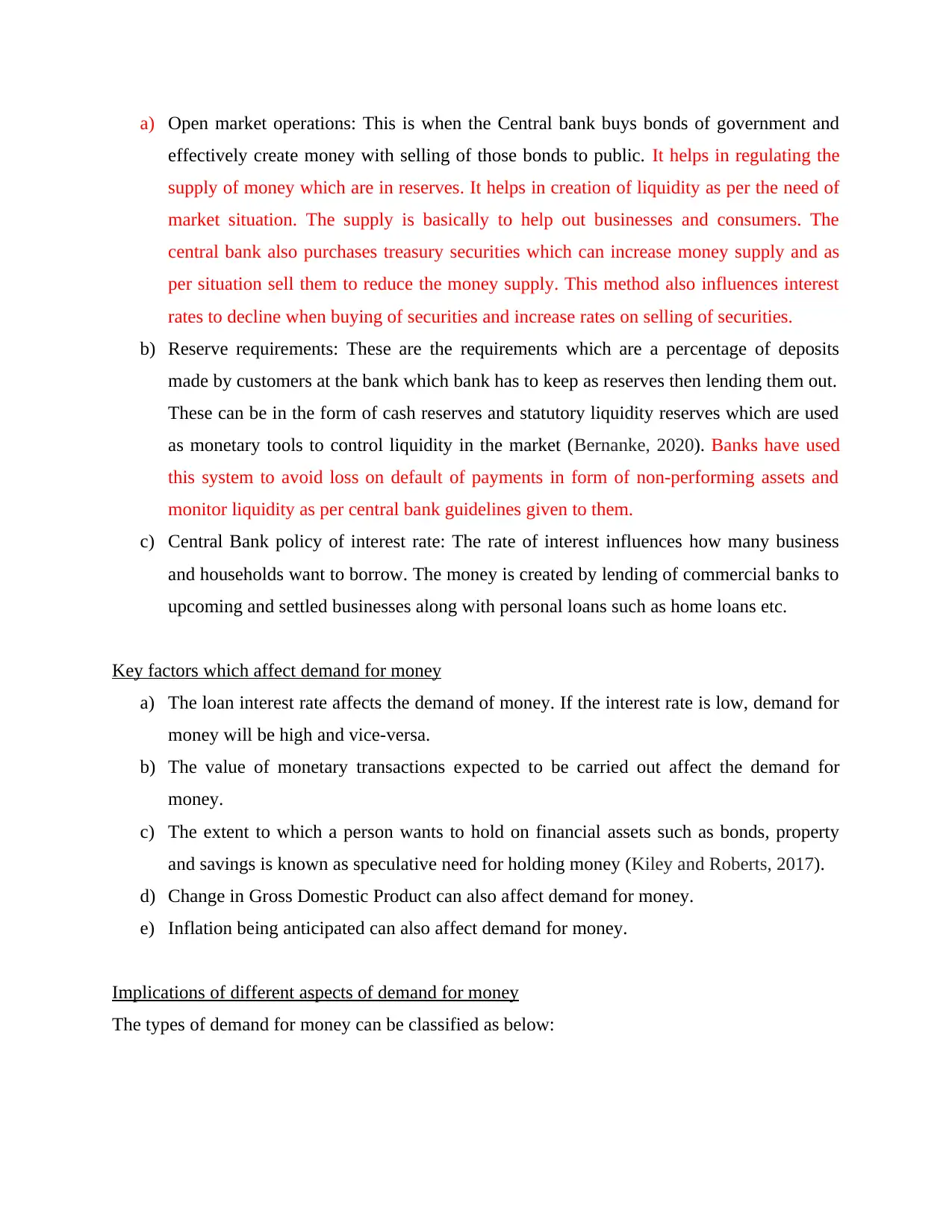
a) Open market operations: This is when the Central bank buys bonds of government and
effectively create money with selling of those bonds to public. It helps in regulating the
supply of money which are in reserves. It helps in creation of liquidity as per the need of
market situation. The supply is basically to help out businesses and consumers. The
central bank also purchases treasury securities which can increase money supply and as
per situation sell them to reduce the money supply. This method also influences interest
rates to decline when buying of securities and increase rates on selling of securities.
b) Reserve requirements: These are the requirements which are a percentage of deposits
made by customers at the bank which bank has to keep as reserves then lending them out.
These can be in the form of cash reserves and statutory liquidity reserves which are used
as monetary tools to control liquidity in the market (Bernanke, 2020). Banks have used
this system to avoid loss on default of payments in form of non-performing assets and
monitor liquidity as per central bank guidelines given to them.
c) Central Bank policy of interest rate: The rate of interest influences how many business
and households want to borrow. The money is created by lending of commercial banks to
upcoming and settled businesses along with personal loans such as home loans etc.
Key factors which affect demand for money
a) The loan interest rate affects the demand of money. If the interest rate is low, demand for
money will be high and vice-versa.
b) The value of monetary transactions expected to be carried out affect the demand for
money.
c) The extent to which a person wants to hold on financial assets such as bonds, property
and savings is known as speculative need for holding money (Kiley and Roberts, 2017).
d) Change in Gross Domestic Product can also affect demand for money.
e) Inflation being anticipated can also affect demand for money.
Implications of different aspects of demand for money
The types of demand for money can be classified as below:
effectively create money with selling of those bonds to public. It helps in regulating the
supply of money which are in reserves. It helps in creation of liquidity as per the need of
market situation. The supply is basically to help out businesses and consumers. The
central bank also purchases treasury securities which can increase money supply and as
per situation sell them to reduce the money supply. This method also influences interest
rates to decline when buying of securities and increase rates on selling of securities.
b) Reserve requirements: These are the requirements which are a percentage of deposits
made by customers at the bank which bank has to keep as reserves then lending them out.
These can be in the form of cash reserves and statutory liquidity reserves which are used
as monetary tools to control liquidity in the market (Bernanke, 2020). Banks have used
this system to avoid loss on default of payments in form of non-performing assets and
monitor liquidity as per central bank guidelines given to them.
c) Central Bank policy of interest rate: The rate of interest influences how many business
and households want to borrow. The money is created by lending of commercial banks to
upcoming and settled businesses along with personal loans such as home loans etc.
Key factors which affect demand for money
a) The loan interest rate affects the demand of money. If the interest rate is low, demand for
money will be high and vice-versa.
b) The value of monetary transactions expected to be carried out affect the demand for
money.
c) The extent to which a person wants to hold on financial assets such as bonds, property
and savings is known as speculative need for holding money (Kiley and Roberts, 2017).
d) Change in Gross Domestic Product can also affect demand for money.
e) Inflation being anticipated can also affect demand for money.
Implications of different aspects of demand for money
The types of demand for money can be classified as below:
⊘ This is a preview!⊘
Do you want full access?
Subscribe today to unlock all pages.

Trusted by 1+ million students worldwide
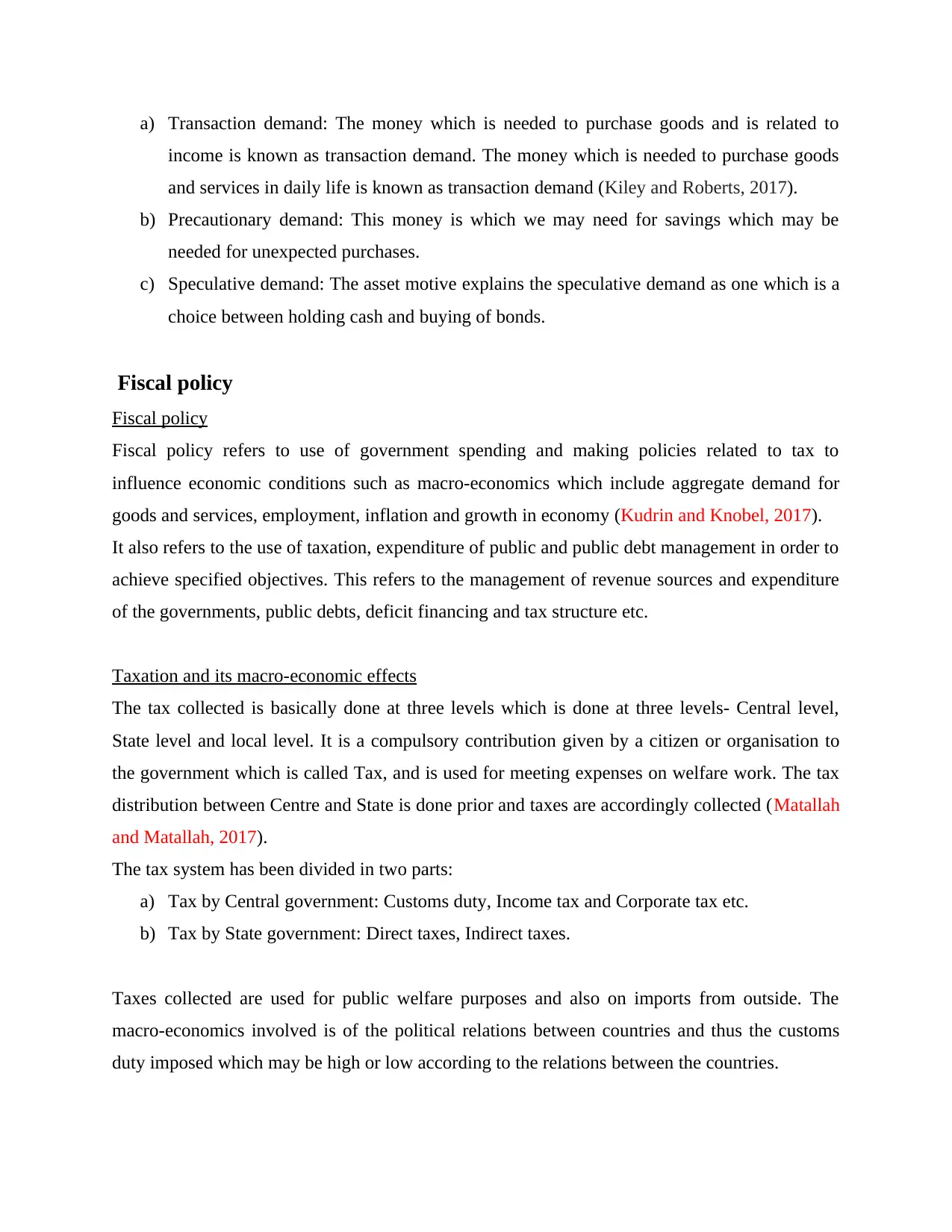
a) Transaction demand: The money which is needed to purchase goods and is related to
income is known as transaction demand. The money which is needed to purchase goods
and services in daily life is known as transaction demand (Kiley and Roberts, 2017).
b) Precautionary demand: This money is which we may need for savings which may be
needed for unexpected purchases.
c) Speculative demand: The asset motive explains the speculative demand as one which is a
choice between holding cash and buying of bonds.
Fiscal policy
Fiscal policy
Fiscal policy refers to use of government spending and making policies related to tax to
influence economic conditions such as macro-economics which include aggregate demand for
goods and services, employment, inflation and growth in economy (Kudrin and Knobel, 2017).
It also refers to the use of taxation, expenditure of public and public debt management in order to
achieve specified objectives. This refers to the management of revenue sources and expenditure
of the governments, public debts, deficit financing and tax structure etc.
Taxation and its macro-economic effects
The tax collected is basically done at three levels which is done at three levels- Central level,
State level and local level. It is a compulsory contribution given by a citizen or organisation to
the government which is called Tax, and is used for meeting expenses on welfare work. The tax
distribution between Centre and State is done prior and taxes are accordingly collected (Matallah
and Matallah, 2017).
The tax system has been divided in two parts:
a) Tax by Central government: Customs duty, Income tax and Corporate tax etc.
b) Tax by State government: Direct taxes, Indirect taxes.
Taxes collected are used for public welfare purposes and also on imports from outside. The
macro-economics involved is of the political relations between countries and thus the customs
duty imposed which may be high or low according to the relations between the countries.
income is known as transaction demand. The money which is needed to purchase goods
and services in daily life is known as transaction demand (Kiley and Roberts, 2017).
b) Precautionary demand: This money is which we may need for savings which may be
needed for unexpected purchases.
c) Speculative demand: The asset motive explains the speculative demand as one which is a
choice between holding cash and buying of bonds.
Fiscal policy
Fiscal policy
Fiscal policy refers to use of government spending and making policies related to tax to
influence economic conditions such as macro-economics which include aggregate demand for
goods and services, employment, inflation and growth in economy (Kudrin and Knobel, 2017).
It also refers to the use of taxation, expenditure of public and public debt management in order to
achieve specified objectives. This refers to the management of revenue sources and expenditure
of the governments, public debts, deficit financing and tax structure etc.
Taxation and its macro-economic effects
The tax collected is basically done at three levels which is done at three levels- Central level,
State level and local level. It is a compulsory contribution given by a citizen or organisation to
the government which is called Tax, and is used for meeting expenses on welfare work. The tax
distribution between Centre and State is done prior and taxes are accordingly collected (Matallah
and Matallah, 2017).
The tax system has been divided in two parts:
a) Tax by Central government: Customs duty, Income tax and Corporate tax etc.
b) Tax by State government: Direct taxes, Indirect taxes.
Taxes collected are used for public welfare purposes and also on imports from outside. The
macro-economics involved is of the political relations between countries and thus the customs
duty imposed which may be high or low according to the relations between the countries.
Paraphrase This Document
Need a fresh take? Get an instant paraphrase of this document with our AI Paraphraser
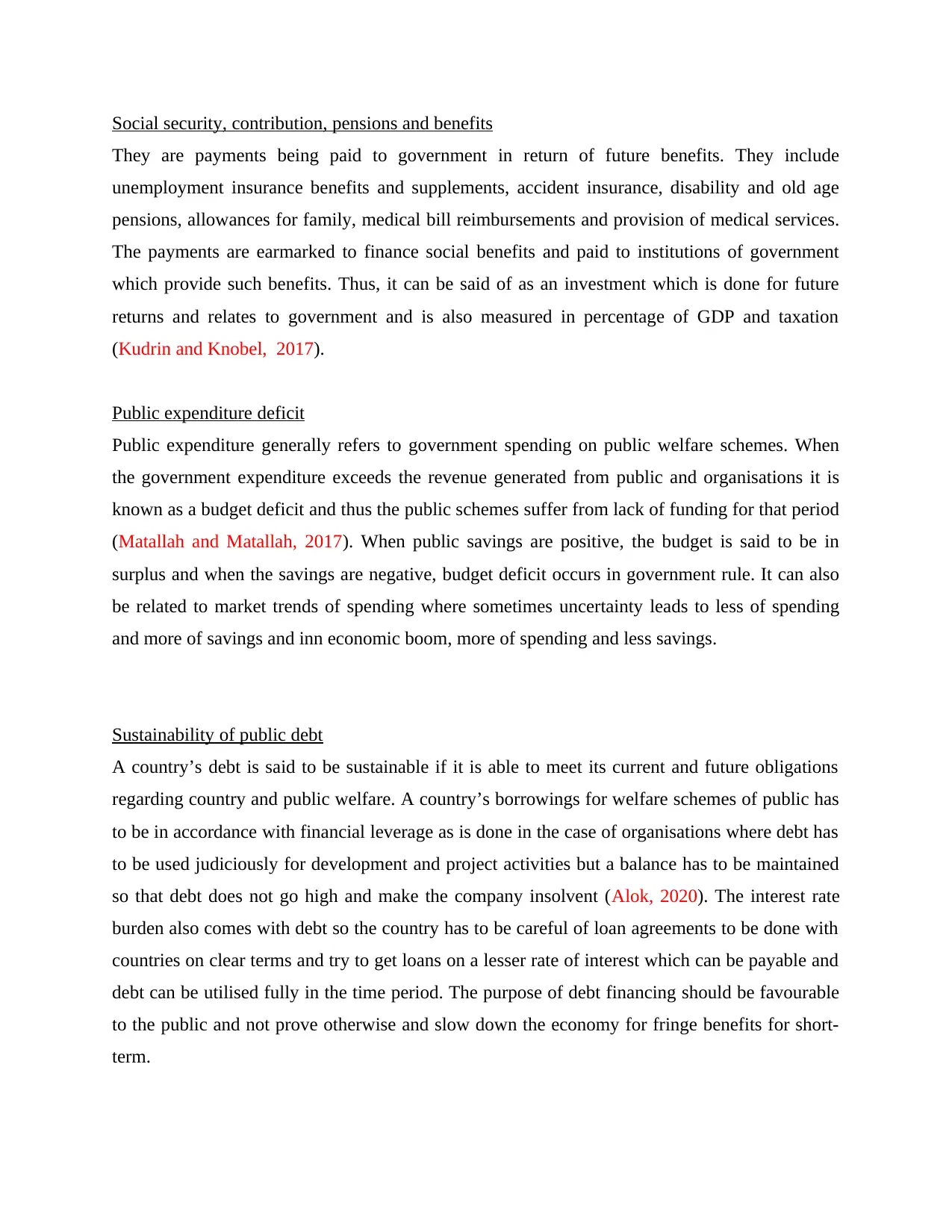
Social security, contribution, pensions and benefits
They are payments being paid to government in return of future benefits. They include
unemployment insurance benefits and supplements, accident insurance, disability and old age
pensions, allowances for family, medical bill reimbursements and provision of medical services.
The payments are earmarked to finance social benefits and paid to institutions of government
which provide such benefits. Thus, it can be said of as an investment which is done for future
returns and relates to government and is also measured in percentage of GDP and taxation
(Kudrin and Knobel, 2017).
Public expenditure deficit
Public expenditure generally refers to government spending on public welfare schemes. When
the government expenditure exceeds the revenue generated from public and organisations it is
known as a budget deficit and thus the public schemes suffer from lack of funding for that period
(Matallah and Matallah, 2017). When public savings are positive, the budget is said to be in
surplus and when the savings are negative, budget deficit occurs in government rule. It can also
be related to market trends of spending where sometimes uncertainty leads to less of spending
and more of savings and inn economic boom, more of spending and less savings.
Sustainability of public debt
A country’s debt is said to be sustainable if it is able to meet its current and future obligations
regarding country and public welfare. A country’s borrowings for welfare schemes of public has
to be in accordance with financial leverage as is done in the case of organisations where debt has
to be used judiciously for development and project activities but a balance has to be maintained
so that debt does not go high and make the company insolvent (Alok, 2020). The interest rate
burden also comes with debt so the country has to be careful of loan agreements to be done with
countries on clear terms and try to get loans on a lesser rate of interest which can be payable and
debt can be utilised fully in the time period. The purpose of debt financing should be favourable
to the public and not prove otherwise and slow down the economy for fringe benefits for short-
term.
They are payments being paid to government in return of future benefits. They include
unemployment insurance benefits and supplements, accident insurance, disability and old age
pensions, allowances for family, medical bill reimbursements and provision of medical services.
The payments are earmarked to finance social benefits and paid to institutions of government
which provide such benefits. Thus, it can be said of as an investment which is done for future
returns and relates to government and is also measured in percentage of GDP and taxation
(Kudrin and Knobel, 2017).
Public expenditure deficit
Public expenditure generally refers to government spending on public welfare schemes. When
the government expenditure exceeds the revenue generated from public and organisations it is
known as a budget deficit and thus the public schemes suffer from lack of funding for that period
(Matallah and Matallah, 2017). When public savings are positive, the budget is said to be in
surplus and when the savings are negative, budget deficit occurs in government rule. It can also
be related to market trends of spending where sometimes uncertainty leads to less of spending
and more of savings and inn economic boom, more of spending and less savings.
Sustainability of public debt
A country’s debt is said to be sustainable if it is able to meet its current and future obligations
regarding country and public welfare. A country’s borrowings for welfare schemes of public has
to be in accordance with financial leverage as is done in the case of organisations where debt has
to be used judiciously for development and project activities but a balance has to be maintained
so that debt does not go high and make the company insolvent (Alok, 2020). The interest rate
burden also comes with debt so the country has to be careful of loan agreements to be done with
countries on clear terms and try to get loans on a lesser rate of interest which can be payable and
debt can be utilised fully in the time period. The purpose of debt financing should be favourable
to the public and not prove otherwise and slow down the economy for fringe benefits for short-
term.
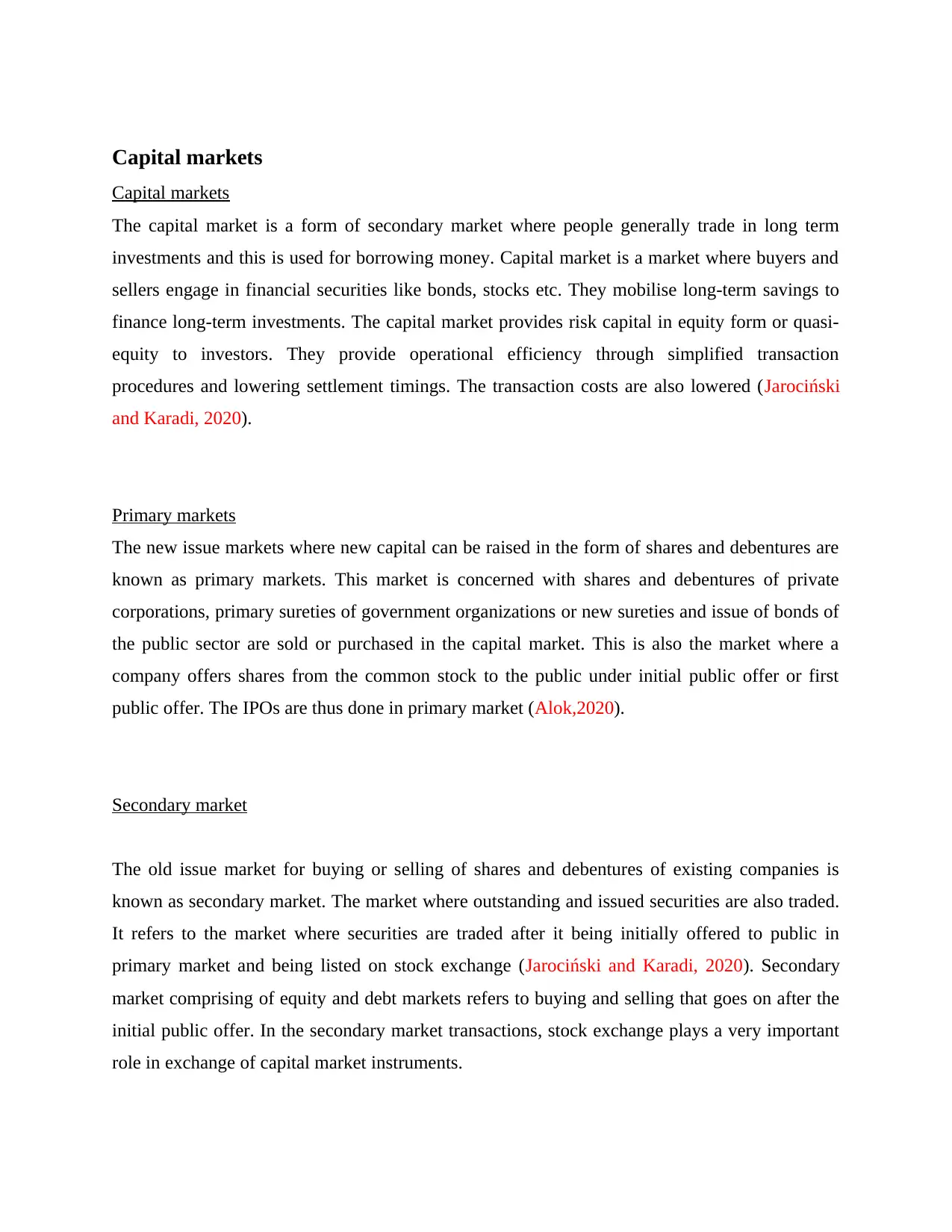
Capital markets
Capital markets
The capital market is a form of secondary market where people generally trade in long term
investments and this is used for borrowing money. Capital market is a market where buyers and
sellers engage in financial securities like bonds, stocks etc. They mobilise long-term savings to
finance long-term investments. The capital market provides risk capital in equity form or quasi-
equity to investors. They provide operational efficiency through simplified transaction
procedures and lowering settlement timings. The transaction costs are also lowered (Jarociński
and Karadi, 2020).
Primary markets
The new issue markets where new capital can be raised in the form of shares and debentures are
known as primary markets. This market is concerned with shares and debentures of private
corporations, primary sureties of government organizations or new sureties and issue of bonds of
the public sector are sold or purchased in the capital market. This is also the market where a
company offers shares from the common stock to the public under initial public offer or first
public offer. The IPOs are thus done in primary market (Alok,2020).
Secondary market
The old issue market for buying or selling of shares and debentures of existing companies is
known as secondary market. The market where outstanding and issued securities are also traded.
It refers to the market where securities are traded after it being initially offered to public in
primary market and being listed on stock exchange (Jarociński and Karadi, 2020). Secondary
market comprising of equity and debt markets refers to buying and selling that goes on after the
initial public offer. In the secondary market transactions, stock exchange plays a very important
role in exchange of capital market instruments.
Capital markets
The capital market is a form of secondary market where people generally trade in long term
investments and this is used for borrowing money. Capital market is a market where buyers and
sellers engage in financial securities like bonds, stocks etc. They mobilise long-term savings to
finance long-term investments. The capital market provides risk capital in equity form or quasi-
equity to investors. They provide operational efficiency through simplified transaction
procedures and lowering settlement timings. The transaction costs are also lowered (Jarociński
and Karadi, 2020).
Primary markets
The new issue markets where new capital can be raised in the form of shares and debentures are
known as primary markets. This market is concerned with shares and debentures of private
corporations, primary sureties of government organizations or new sureties and issue of bonds of
the public sector are sold or purchased in the capital market. This is also the market where a
company offers shares from the common stock to the public under initial public offer or first
public offer. The IPOs are thus done in primary market (Alok,2020).
Secondary market
The old issue market for buying or selling of shares and debentures of existing companies is
known as secondary market. The market where outstanding and issued securities are also traded.
It refers to the market where securities are traded after it being initially offered to public in
primary market and being listed on stock exchange (Jarociński and Karadi, 2020). Secondary
market comprising of equity and debt markets refers to buying and selling that goes on after the
initial public offer. In the secondary market transactions, stock exchange plays a very important
role in exchange of capital market instruments.
⊘ This is a preview!⊘
Do you want full access?
Subscribe today to unlock all pages.

Trusted by 1+ million students worldwide
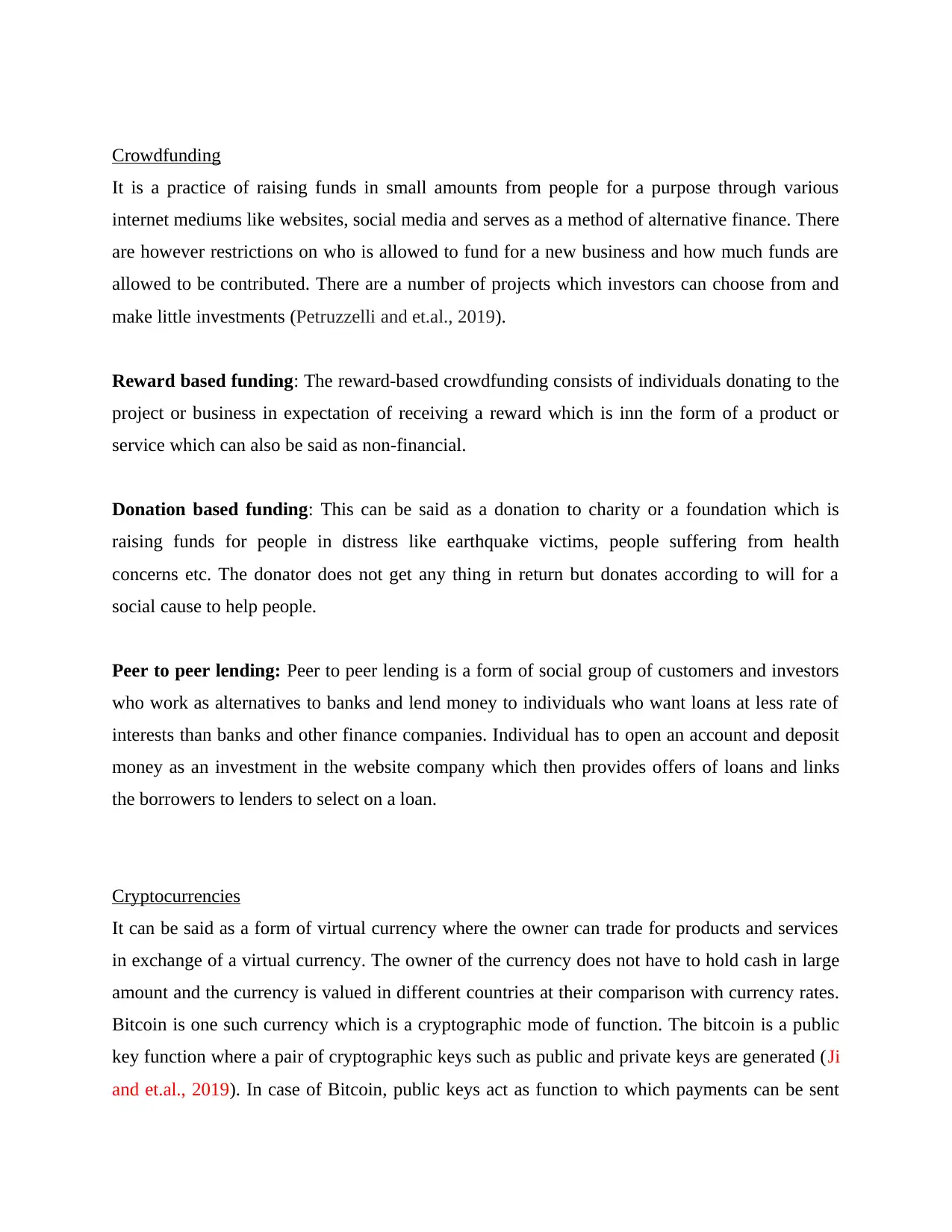
Crowdfunding
It is a practice of raising funds in small amounts from people for a purpose through various
internet mediums like websites, social media and serves as a method of alternative finance. There
are however restrictions on who is allowed to fund for a new business and how much funds are
allowed to be contributed. There are a number of projects which investors can choose from and
make little investments (Petruzzelli and et.al., 2019).
Reward based funding: The reward-based crowdfunding consists of individuals donating to the
project or business in expectation of receiving a reward which is inn the form of a product or
service which can also be said as non-financial.
Donation based funding: This can be said as a donation to charity or a foundation which is
raising funds for people in distress like earthquake victims, people suffering from health
concerns etc. The donator does not get any thing in return but donates according to will for a
social cause to help people.
Peer to peer lending: Peer to peer lending is a form of social group of customers and investors
who work as alternatives to banks and lend money to individuals who want loans at less rate of
interests than banks and other finance companies. Individual has to open an account and deposit
money as an investment in the website company which then provides offers of loans and links
the borrowers to lenders to select on a loan.
Cryptocurrencies
It can be said as a form of virtual currency where the owner can trade for products and services
in exchange of a virtual currency. The owner of the currency does not have to hold cash in large
amount and the currency is valued in different countries at their comparison with currency rates.
Bitcoin is one such currency which is a cryptographic mode of function. The bitcoin is a public
key function where a pair of cryptographic keys such as public and private keys are generated (Ji
and et.al., 2019). In case of Bitcoin, public keys act as function to which payments can be sent
It is a practice of raising funds in small amounts from people for a purpose through various
internet mediums like websites, social media and serves as a method of alternative finance. There
are however restrictions on who is allowed to fund for a new business and how much funds are
allowed to be contributed. There are a number of projects which investors can choose from and
make little investments (Petruzzelli and et.al., 2019).
Reward based funding: The reward-based crowdfunding consists of individuals donating to the
project or business in expectation of receiving a reward which is inn the form of a product or
service which can also be said as non-financial.
Donation based funding: This can be said as a donation to charity or a foundation which is
raising funds for people in distress like earthquake victims, people suffering from health
concerns etc. The donator does not get any thing in return but donates according to will for a
social cause to help people.
Peer to peer lending: Peer to peer lending is a form of social group of customers and investors
who work as alternatives to banks and lend money to individuals who want loans at less rate of
interests than banks and other finance companies. Individual has to open an account and deposit
money as an investment in the website company which then provides offers of loans and links
the borrowers to lenders to select on a loan.
Cryptocurrencies
It can be said as a form of virtual currency where the owner can trade for products and services
in exchange of a virtual currency. The owner of the currency does not have to hold cash in large
amount and the currency is valued in different countries at their comparison with currency rates.
Bitcoin is one such currency which is a cryptographic mode of function. The bitcoin is a public
key function where a pair of cryptographic keys such as public and private keys are generated (Ji
and et.al., 2019). In case of Bitcoin, public keys act as function to which payments can be sent
Paraphrase This Document
Need a fresh take? Get an instant paraphrase of this document with our AI Paraphraser
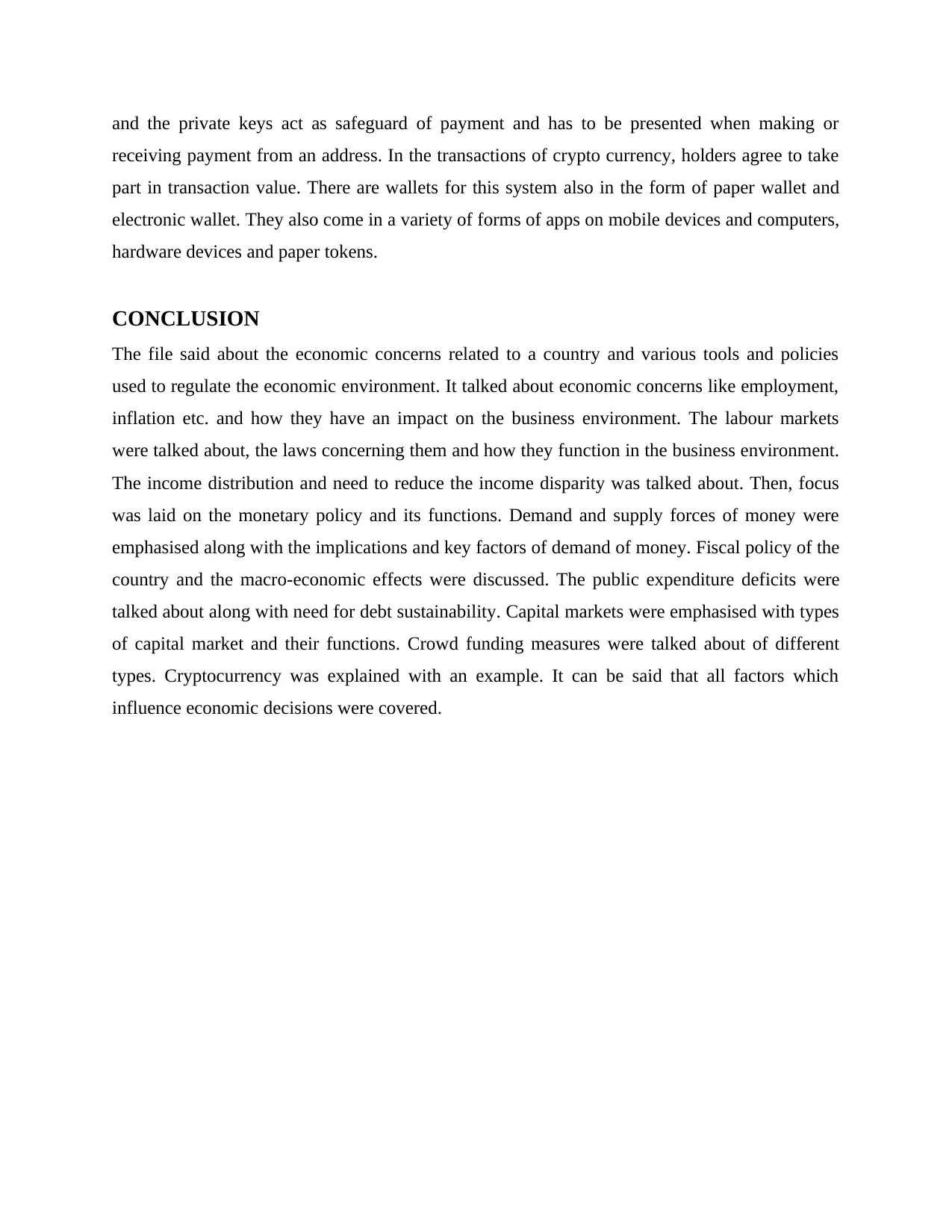
and the private keys act as safeguard of payment and has to be presented when making or
receiving payment from an address. In the transactions of crypto currency, holders agree to take
part in transaction value. There are wallets for this system also in the form of paper wallet and
electronic wallet. They also come in a variety of forms of apps on mobile devices and computers,
hardware devices and paper tokens.
CONCLUSION
The file said about the economic concerns related to a country and various tools and policies
used to regulate the economic environment. It talked about economic concerns like employment,
inflation etc. and how they have an impact on the business environment. The labour markets
were talked about, the laws concerning them and how they function in the business environment.
The income distribution and need to reduce the income disparity was talked about. Then, focus
was laid on the monetary policy and its functions. Demand and supply forces of money were
emphasised along with the implications and key factors of demand of money. Fiscal policy of the
country and the macro-economic effects were discussed. The public expenditure deficits were
talked about along with need for debt sustainability. Capital markets were emphasised with types
of capital market and their functions. Crowd funding measures were talked about of different
types. Cryptocurrency was explained with an example. It can be said that all factors which
influence economic decisions were covered.
receiving payment from an address. In the transactions of crypto currency, holders agree to take
part in transaction value. There are wallets for this system also in the form of paper wallet and
electronic wallet. They also come in a variety of forms of apps on mobile devices and computers,
hardware devices and paper tokens.
CONCLUSION
The file said about the economic concerns related to a country and various tools and policies
used to regulate the economic environment. It talked about economic concerns like employment,
inflation etc. and how they have an impact on the business environment. The labour markets
were talked about, the laws concerning them and how they function in the business environment.
The income distribution and need to reduce the income disparity was talked about. Then, focus
was laid on the monetary policy and its functions. Demand and supply forces of money were
emphasised along with the implications and key factors of demand of money. Fiscal policy of the
country and the macro-economic effects were discussed. The public expenditure deficits were
talked about along with need for debt sustainability. Capital markets were emphasised with types
of capital market and their functions. Crowd funding measures were talked about of different
types. Cryptocurrency was explained with an example. It can be said that all factors which
influence economic decisions were covered.
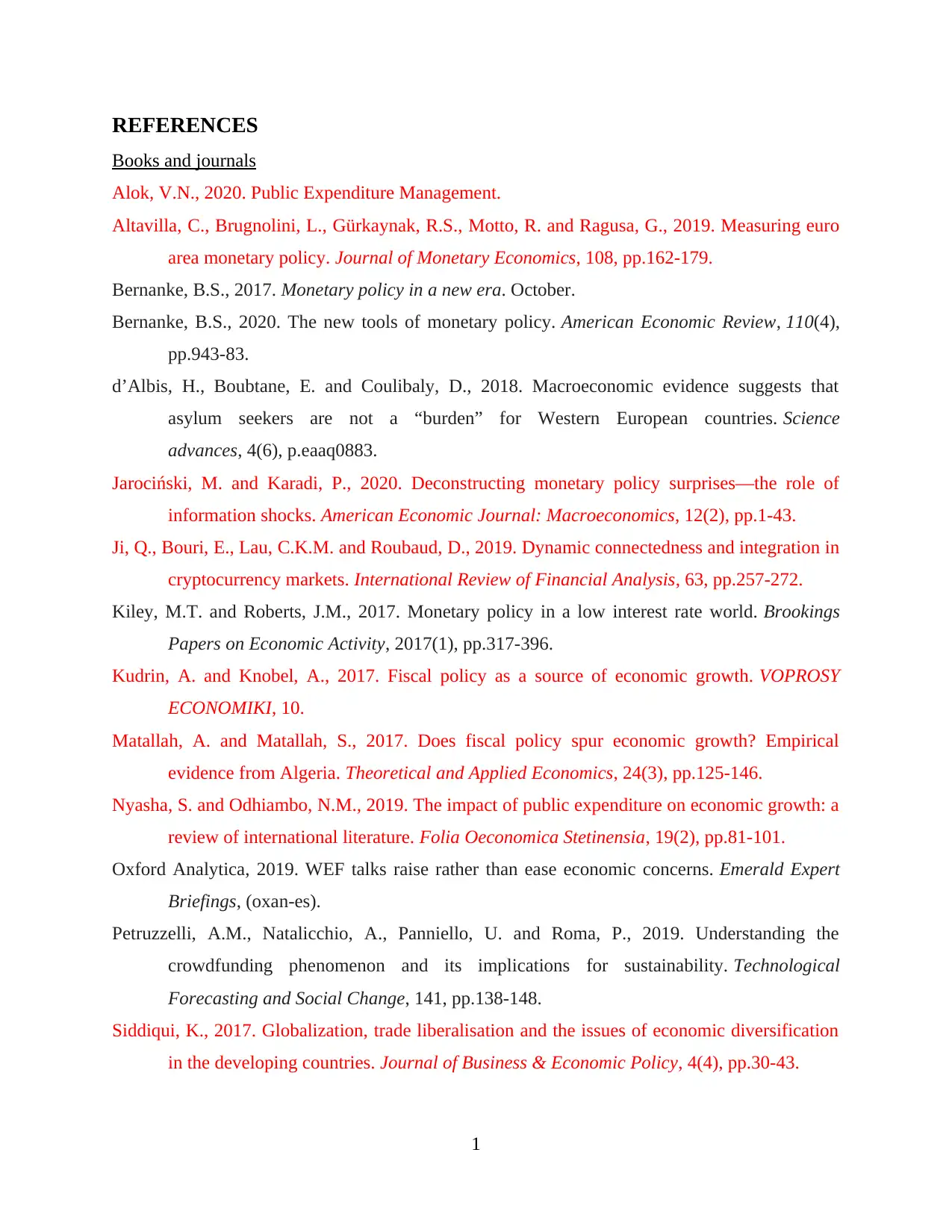
REFERENCES
Books and journals
Alok, V.N., 2020. Public Expenditure Management.
Altavilla, C., Brugnolini, L., Gürkaynak, R.S., Motto, R. and Ragusa, G., 2019. Measuring euro
area monetary policy. Journal of Monetary Economics, 108, pp.162-179.
Bernanke, B.S., 2017. Monetary policy in a new era. October.
Bernanke, B.S., 2020. The new tools of monetary policy. American Economic Review, 110(4),
pp.943-83.
d’Albis, H., Boubtane, E. and Coulibaly, D., 2018. Macroeconomic evidence suggests that
asylum seekers are not a “burden” for Western European countries. Science
advances, 4(6), p.eaaq0883.
Jarociński, M. and Karadi, P., 2020. Deconstructing monetary policy surprises—the role of
information shocks. American Economic Journal: Macroeconomics, 12(2), pp.1-43.
Ji, Q., Bouri, E., Lau, C.K.M. and Roubaud, D., 2019. Dynamic connectedness and integration in
cryptocurrency markets. International Review of Financial Analysis, 63, pp.257-272.
Kiley, M.T. and Roberts, J.M., 2017. Monetary policy in a low interest rate world. Brookings
Papers on Economic Activity, 2017(1), pp.317-396.
Kudrin, A. and Knobel, A., 2017. Fiscal policy as a source of economic growth. VOPROSY
ECONOMIKI, 10.
Matallah, A. and Matallah, S., 2017. Does fiscal policy spur economic growth? Empirical
evidence from Algeria. Theoretical and Applied Economics, 24(3), pp.125-146.
Nyasha, S. and Odhiambo, N.M., 2019. The impact of public expenditure on economic growth: a
review of international literature. Folia Oeconomica Stetinensia, 19(2), pp.81-101.
Oxford Analytica, 2019. WEF talks raise rather than ease economic concerns. Emerald Expert
Briefings, (oxan-es).
Petruzzelli, A.M., Natalicchio, A., Panniello, U. and Roma, P., 2019. Understanding the
crowdfunding phenomenon and its implications for sustainability. Technological
Forecasting and Social Change, 141, pp.138-148.
Siddiqui, K., 2017. Globalization, trade liberalisation and the issues of economic diversification
in the developing countries. Journal of Business & Economic Policy, 4(4), pp.30-43.
1
Books and journals
Alok, V.N., 2020. Public Expenditure Management.
Altavilla, C., Brugnolini, L., Gürkaynak, R.S., Motto, R. and Ragusa, G., 2019. Measuring euro
area monetary policy. Journal of Monetary Economics, 108, pp.162-179.
Bernanke, B.S., 2017. Monetary policy in a new era. October.
Bernanke, B.S., 2020. The new tools of monetary policy. American Economic Review, 110(4),
pp.943-83.
d’Albis, H., Boubtane, E. and Coulibaly, D., 2018. Macroeconomic evidence suggests that
asylum seekers are not a “burden” for Western European countries. Science
advances, 4(6), p.eaaq0883.
Jarociński, M. and Karadi, P., 2020. Deconstructing monetary policy surprises—the role of
information shocks. American Economic Journal: Macroeconomics, 12(2), pp.1-43.
Ji, Q., Bouri, E., Lau, C.K.M. and Roubaud, D., 2019. Dynamic connectedness and integration in
cryptocurrency markets. International Review of Financial Analysis, 63, pp.257-272.
Kiley, M.T. and Roberts, J.M., 2017. Monetary policy in a low interest rate world. Brookings
Papers on Economic Activity, 2017(1), pp.317-396.
Kudrin, A. and Knobel, A., 2017. Fiscal policy as a source of economic growth. VOPROSY
ECONOMIKI, 10.
Matallah, A. and Matallah, S., 2017. Does fiscal policy spur economic growth? Empirical
evidence from Algeria. Theoretical and Applied Economics, 24(3), pp.125-146.
Nyasha, S. and Odhiambo, N.M., 2019. The impact of public expenditure on economic growth: a
review of international literature. Folia Oeconomica Stetinensia, 19(2), pp.81-101.
Oxford Analytica, 2019. WEF talks raise rather than ease economic concerns. Emerald Expert
Briefings, (oxan-es).
Petruzzelli, A.M., Natalicchio, A., Panniello, U. and Roma, P., 2019. Understanding the
crowdfunding phenomenon and its implications for sustainability. Technological
Forecasting and Social Change, 141, pp.138-148.
Siddiqui, K., 2017. Globalization, trade liberalisation and the issues of economic diversification
in the developing countries. Journal of Business & Economic Policy, 4(4), pp.30-43.
1
⊘ This is a preview!⊘
Do you want full access?
Subscribe today to unlock all pages.

Trusted by 1+ million students worldwide
1 out of 13
Related Documents
Your All-in-One AI-Powered Toolkit for Academic Success.
+13062052269
info@desklib.com
Available 24*7 on WhatsApp / Email
![[object Object]](/_next/static/media/star-bottom.7253800d.svg)
Unlock your academic potential
Copyright © 2020–2025 A2Z Services. All Rights Reserved. Developed and managed by ZUCOL.





